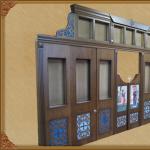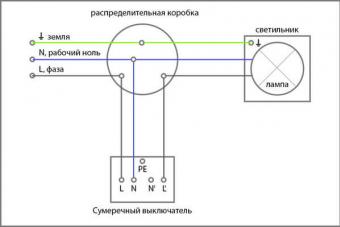No matter how fast progress develops, gardening tools in the form of shovels, rakes, choppers and brooms remain as necessary for a person as they were a hundred years ago.
The handles of these tools are most often made of wood, so over time they wear out, break and require replacement. In the spring and summer, when the time comes for vegetable gardens and summer cottages, the demand for such devices rises sharply, which makes it possible for some enterprising citizens to make good money on this.
Big idea for small business
The production of cuttings for spades, choppers, brooms and other hand tools, with the proper approach, can become a low-cost, but very profitable own business. Very often, large enterprises specializing in woodworking use this type of commerce in order to generate additional income, because, in fact, the material for the handles is wood waste.
Having a separate room with power supply and equipment for the production of cuttings, you can earn good money without much effort and expense. To organize a constant supply of raw materials, it is better to negotiate with representatives of woodworking or furniture factories, or find an outlet for private entrepreneurs who have a sawmill.
Equipment for the production of cuttings and its cost
As a rule, three machines are included in the standard complex for the manufacture of wooden handles:
- round stick (designed to clean the workpiece and give it a cylindrical shape);
- circular grinding (makes the surface smooth);
- trimming (smooths one end of the product and sharpens the other).
The cost of such equipment will depend on its brand, technical condition and productivity.

On average, a new machine for the production of cuttings costs about 150 thousand rubles, the price for a grinding machine is about 70 thousand rubles, and for a trimmer - 60,000 rubles. As a result, for a successful start, taking into account consumables, you will need at least 300 thousand rubles. You can also buy used equipment, saving about a third of the necessary funds, or take out leasing.
Manufacturing technology
It should be borne in mind that only hardwoods such as birch, oak, beech and ash are used in the production of holders. Coniferous wood is not suitable due to the presence of resinous substances. The handles made of birch and ash are considered the best.
To establish the marketing of future products, it is necessary to adhere to certain criteria established for this type of product. Hand tool handles are manufactured in accordance with the conditions of GOST 2695-83, which classifies them by quality into three grades:

- the highest grade (no knots, wood moisture up to 10%);
- first grade (no more than 2-3 knots per product, up to 3 mm in diameter, humidity not more than 30%);
- second grade (no more than 2-3 knots, up to 7 mm in diameter, wood moisture up to 60%).
In addition to these requirements, generally accepted standards for the diameter of handles have been established depending on their purpose:
- for shovels - 40 mm;
- for hoes - 30 mm;
- for rakes, choppers and brooms - 25 mm.
The length of products is usually 1100-1300 mm.
Sales
Not only gardeners and summer residents are potential buyers. Utilities year-round purchase for their needs both ready-made tools and handles for them, so there are usually no issues with the sale of products.
Farmers who use manual labor in the fields are no exception. You can also offer your product to large construction companies, educational institutions. A good solution would be to conclude contracts with hardware stores or just retail in the market.
Profitability
The average market price of one holder of the highest grade in Russia is 25 rubles, the first - half the price. Given the approximate cost of one unit of 5 rubles and the average daily productivity of a mini-workshop of 500 units, you can earn about 200 thousand rubles per month. Now you should subtract the cost of electricity, consumables, salaries of employees, taxes.

Thus, the net monthly income will be at least 100,000 rubles, and the purchased equipment for the production of cuttings for shovels and other tools will pay off in about 3 months.
It is difficult to find a more popular and well-known tool than a shovel. Despite the active growth of mechanized devices and assemblies, in some cases only a shovel is able to cope with the task. What is a shovel? This is a manual type tool that is designed to work with soil, building materials and bulk materials and is used for clearing, pouring, and other works.
The prototype of modern shovels can be considered a tool that appeared in the Stone Age and was a pointed flat stone, which was connected by straps made of skins with a wooden bough. Its first purpose was to dig pits for animals and obtain edible root crops. The ancient Chinese improved the shovel, making it iron, and the impetus for its invention was problems with a lack of water, and shovels helped dig some of the first irrigation canals in the world.
Kinds
Despite the simplicity of the design of the shovel, which only shovels do not exist today, and depending on the purpose of their application and the blades used in the design, the following types of shovels are distinguished:
- scoop (square shape). It is intended for work with loose materials, such as grain, sand, crushed stone, gravel, etc.;
- digging or bayonet (flat with a pointed or rectangular shape and protrusions at the top). It is used in agriculture and when performing any earthmoving work;
- for snow removal (made with a wide scoop made of plywood, plastic and aluminum with stiffeners);
- snow-grain (universal for snow removal and unloading of grain and light bulk cargo);
- mining or coal (shovel for working with coal, mainly in mines)
- scoop (shovel for working with garbage with a short handle);
- infantry shovel or sapper shovel (a small shovel for opening a small trench).
During the existence of the Soviet Union, the state clearly regulated the production of a shovel, and a special state standard 19596-87 was issued, which indicated its types and main dimensions. So, for example, shovels were classified into construction, handling and gardening.
Structurally, the device of the shovel is very simple and consists of a handle and a bayonet. But how are shovels made and is it possible to talk about a full-fledged production of shovels? This will be discussed below.
Shovel production technology
For the most part, shovel handles are made according to a fairly simple process, and it consists only in the correct configuration and processing of wooden blanks, as a result of future shovel handles. The length of the handle depends on the type of shovel and most often is 120-130 cm and a diameter of 40 mm. For the manufacture of cuttings, he uses wooden species of deciduous trees, most of all they are found from birch, less often - ash and alder. The use of conifers is undesirable due to their heavy and resinous wood. In modern production, it is customary to distinguish 3 varieties of cuttings:
- The highest grade (complete absence of knots and burrs).
- First grade (a small number of knots up to 3mm).
- Second grade (a small number of knots up to 7mm).
The most important thing in the production technology of shovels is the manufacture of a blade; the service life of a shovel and its functionality directly depend on the quality of the blade. In the production of a blade of any shovel, the use of a complex technological process, as well as special equipment, is required.
All stages of the technology for the production of shovels (blades) can be divided into 4:
- Mechanical restoration. With the help of a special machine - a guillotine, the shape of a shovel is made by cutting it out of the canvas. The type of guillotine used is selected based on the size of the metal sheet, which will later serve as the basis for the bayonet. In the future, finished blanks are processed on a variety of presses with stamps, where they are already given their final shape and size. Having passed the stamping stage, the bayonets are sharpened along the edge.
- Welding works. A tulle is welded to the finished workpiece, the purpose of which is to hold the stalk.
- Anti-corrosion robots. To prevent the formation of corrosion on the bayonet, special anti-corrosion agents are applied to it - galvanizing or polymer coating (carried out by hot or galvanized), painting. Then the blade is dried in a special drying chamber.
- At the last stage, the bayonet and the handle of the shovel are connected.
Equipment for the production of shovels
All equipment that is used for the production of shovels can be divided into 2 large groups: the first is the machines and machines involved in the production of cuttings, and the second is special equipment needed for the manufacture of bayonets (blades).
Based on the goals in the production of cuttings, the following equipment is used:
- round stick machine (performs the task of giving a rounded shape to the handle);
- circular grinding machine (handling grinding);
- butt smoothing machine (gives a conical shape to the handle and makes it comfortable to use in hands).
Video how bayonet is made:
Of course, you can also from other steel.
For the production of steel blades, you will need a guillotine, a press with a set of various dies, a drilling machine, a grinding machine, welding equipment, galvanizing equipment (bath or mechanism for thermal diffusion galvanizing), a chamber for painting and drying the finished product.
In the case of the production of plastic shovels and scoops, the equipment for the production of shovels includes an extruder and a drying chamber.
A cutting is a piece of wood for attaching a tool to it. Basically, they are made for agricultural implements, namely, for shovels, rakes, pitchforks and brooms. The cuttings are made from beech, ash, birch or oak, that is, from deciduous trees. It should be noted that high-quality cuttings that will meet all operational requirements can only be produced on special machines.
The production of cuttings for garden tools is most often an additional and non-core activity in the sawmill and logging industry as a monetization of forest waste. However, having good sources of raw materials and having access to profitable markets, such production can become the main and quite profitable.
Such products are usually most in demand during the period from March to June. Of course, the increase in demand is associated with the onset of the agricultural season. Direct consumers of such a product are in a hurry to upgrade and buy more inventory.
Technology for the production of cuttings and equipment
Production requires compliance with technological conditions. Otherwise, it may adversely affect the quality of the product. When selecting wood for production, one should take into account the conditions in which this product will be used.
For a rake or broom, it is best to use hardwood and softwood, and for hammers, sledgehammers or axes, the most durable trees.
One way or another, you first need to bring the raw material into the desired shape, that is, it must be leveled, cut, give it approximate contours and machined. The size of the workpiece should be almost the same as the diameter of the cutting being harvested, about 3-4 cm. For the processing of cuttings, a specialized woodworking machine is used. The finished product must be sanded, polished and, if necessary, painted or varnished.
Video how to make cuttings:
The handle should not have any cracks, burrs, chips, roughness. No more than three knots are allowed. Finished products are sorted, labeled and packaged for transportation. Production also includes testing the product for strength and moisture content, which should not exceed 14%. Typically, the handle for shovels has a length of 120-130 millimeters, a diameter of 40 millimeters.
Deciduous species of trees (alder, birch and beech) are used for production. From coniferous trees, for example, pine, cedar, products are made for certain needs of enterprises. This is due to the fact that conifers are very resinous and heavy.
Cuttings are divided into varieties:
- Without knots - the highest grade.
- The presence of knots is allowed, no more than three millimeters in size - the first grade.
- The presence of several knots up to 7 millimeters in size is allowed - the second grade. The size of tobacco knots is up to 4 millimeters.
For the manufacture of spade cuttings, it is necessary to give a rounded shape to this workpiece and grind it so that it is as convenient as possible to use it. First of all, they round and sharpen the end (like a cone). To give a rounded shape to the handle, use a round stick machine.
Using a universal round stick machine, you can not only make cuttings, but also other cylindrical blanks. On such equipment, it is possible to process a variety of tree species, as well as wood of different softness.
When choosing a machine, you should pay attention to the fact that they may have different performance. For small organizations for which woodworking is not the main activity, it is best to buy a machine with the lowest power. This will enable you to save money. For large enterprises, of course, a machine with maximum productivity is suitable. When buying machines, pay attention to the availability of quality certificates.
Grinding the handle on a grinding machine is very high quality and fast. And it is also easily smoothed and given a conical shape to the end of the handle.
As a rule, for large deliveries, the cuttings are not given a conical shape. Round the workpiece from one end only. A similar form is given only for delivery to and during the assembly of ready-made inventory.
This type of business is developed at the enterprises of the woodworking industry, as an additional option. For the production of cuttings, waste wood or young growth and shrubs are used, which are the result of clearing the forest. In the case of an established source of raw materials and a capacious market for cuttings, an entrepreneur can make this type of activity profitable and transform it into the main one.
An active demand for cuttings is formed with the onset of spring, when summer residents begin to resort to land work and cleaning the local area. They are not only ready to upgrade their inventory, but also to increase it. The period of consistently high sales lasts almost three full months: from March to the end of May.
Standards
Each type of tool has its own cutting standards. The size of the diameter of the product for the most common inventory is as follows:
- shovels - 40 mm,
- choppers, hoes - 30 mm,
- rake - 25 mm,
- brooms and brooms - 20 mm.
The length of the product is on average 1200-1300 mm.
Classification of cuttings according to GOST 2695-83:
- The highest grade - the complete absence of visible knots, humidity up to 10%.
- First grade - 2-3 knots per meter of product with a diameter of up to 3 mm, humidity not more than 30%.
- The second grade - 2-3 knots with a diameter of up to 7 mm, humidity up to 60%.
The source for the production of cuttings is the wood of birch, maple, ash or aspen. Products made from coniferous trees are also good, but they are distinguished by their large weight and resinous deposits. Therefore, such cuttings are mainly used for local needs of manufacturing enterprises. The most demanded in the market are birch cuttings.
Equipment for the production of cuttings and technology
The production of cuttings is a mechanized process, which consists of three stages: clean the wood and give the workpiece an appropriate rounded shape; apply grinding, making the product smooth; give one of the ends a conical shape, and round the other. All technology and equipment for the production of cuttings is as follows:
- At the first stage, a round stick machine is used. The cost of such new equipment is about 100-150 thousand rubles.
- The second stage is designed to perform a circular grinding machine, which will cost 60-80 thousand rubles.
- In the third stage, a machine is used to smooth one and sharpen the other end of the handle. The price of such equipment is 50-60 thousand rubles.
It all looks like this - video:
The total price for all equipment for doing business on cuttings will be 250-350 thousand rubles.
As a rule, the wholesale sale of cuttings does not imply the creation of a conical shape for one of the ends. But in the case of sales to stores, in order to complete with ready-made shovels, such an end is necessary.
Sales options
This type of business is not based on advertising. The main thing here is to find distribution channels and in a timely manner, long before the start of spring agricultural work, to provide points of sale with the necessary number of products. You can sell cuttings to the following institutions:
- agricultural and construction stores, supermarkets,
- construction markets, spring fairs,
- business units of administrative structures, schools, kindergartens, universities,
- Homeowners' association, ZhEK, correctional facilities,
- farms, cooperatives, etc.
The ideal option for retailing cuttings is to go to traffic flows, which are actively used by summer residents.





